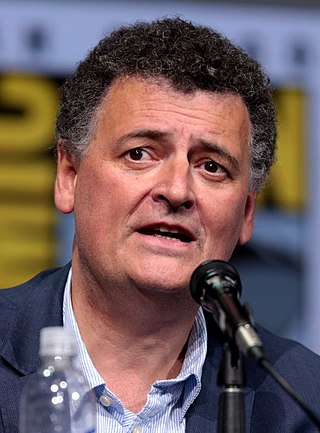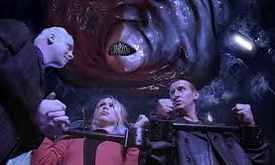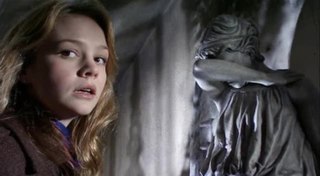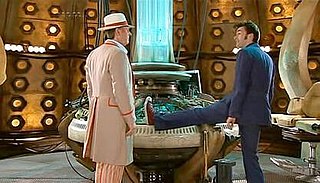
Steven William Moffat is a Scottish television writer, television producer and screenwriter. He is best known for his work as the second showrunner and head writer of the 2005 revival of the BBC sci-fi television series Doctor Who (2010–2017) and co-creating and co-writing the contemporary crime drama television series Sherlock, based on Sir Arthur Conan Doyle's Sherlock Holmes stories (2010–2017). In the 2015 Birthday Honours, Moffat was appointed Officer of the Order of the British Empire (OBE) for his services to drama.

"The Unquiet Dead" is the third episode of the first series of the British science-fiction television programme Doctor Who, first broadcast on 9 April 2005 on BBC One. It was written by Mark Gatiss and directed by Euros Lyn.

"The Long Game" is the seventh episode of the first series of the British science fiction television programme Doctor Who that was first broadcast on 7 May 2005 on BBC One. It was written by executive producer Russell T Davies and directed by Brian Grant.
"Father's Day" is the eighth episode of the first series of the British science fiction television programme Doctor Who, first broadcast on 14 May 2005 on BBC One. It was written by Paul Cornell and directed by Joe Ahearne. It was one of three Doctor Who episodes that year to be nominated for the 2006 Hugo Award for Best Dramatic Presentation, Short Form.
"The Empty Child" is the ninth episode of the first series of the British science fiction television programme Doctor Who, which was first broadcast on BBC One on 21 May 2005. It was directed by James Hawes, and was the first official episode written by Steven Moffat, who previously wrote the Comic Relief mini-episode "The Curse of Fatal Death" in 1999. He would later become the showrunner and main writer of Doctor Who from the fifth to tenth series. "The Empty Child" is the first of a two-part story, which continued and concluded with "The Doctor Dances", on 28 May.

"Boom Town" is the eleventh episode of the first series of the British science fiction television programme Doctor Who. The episode was first broadcast on BBC One on 4 June 2005. It was written by executive producer Russell T Davies and directed by Joe Ahearne.
"Bad Wolf" is the twelfth episode of the revived first series of the British science fiction television series Doctor Who. The episode was first broadcast on BBC One on 11 June 2005. It is the first of a two-part story. The concluding episode, "The Parting of the Ways", was first broadcast on 18 June 2005.
"The Parting of the Ways" is the thirteenth episode and the season finale of the revived first series of the British science fiction television programme Doctor Who. The episode was first broadcast on BBC One on 18 June 2005. It was the second episode of the two-part story. The first part, "Bad Wolf", was broadcast on 11 June.
"The Christmas Invasion" is a 60-minute special episode of the British science fiction television programme Doctor Who, first broadcast on BBC One on 25 December 2005. It was written by showrunner and executive producer Russell T Davies and was directed by James Hawes.
"Tooth and Claw" is the second episode of the second series of the British science fiction television series Doctor Who, which was first broadcast on BBC One on 22 April 2006.
"The Satan Pit" is the ninth episode of the second series of the British science fiction television series Doctor Who, which was first broadcast on 10 June 2006. It is the second part of a two-part story. The first part, "The Impossible Planet", was broadcast on 3 June.
"The Girl in the Fireplace" is the fourth episode of the second series of the British science fiction television series Doctor Who. It was first broadcast on BBC One on 6 May 2006. Written by Steven Moffat and directed by Euros Lyn, the episode is inspired by Audrey Niffenegger's novel The Time Traveler's Wife.

"Doomsday" is the thirteenth and final episode in the second series of the revival of the British science fiction television programme Doctor Who. It was first broadcast on 8 July 2006 and is the conclusion of a two-part story; the first part, "Army of Ghosts", was broadcast on 1 July 2006. The two-part story features the Daleks, presumed extinct after the events of the 2005 series' finale, and the Cybermen, who appeared in a parallel universe in the 2006 episodes "Rise of the Cybermen" and "The Age of Steel". Both species unexpectedly arrive on Earth at the conclusion of "Army of Ghosts".
"Rise of the Cybermen" is the fifth episode of the second series of the British science fiction television programme Doctor Who, which was first broadcast on BBC One on 13 May 2006. The episode introduces a terrestrial reinvention of the Cybermen, as well as a parallel universe which would serve as a recurring plot element in the series. It is the first part of a two-part story, the concluding part being "The Age of Steel", broadcast on 20 May.

"Love & Monsters" is the tenth episode of the second series of the British science fiction television series Doctor Who, which was first broadcast on BBC One on 17 June 2006. It was written by executive producer and lead writer Russell T Davies and directed by Dan Zeff.

"Blink" is the tenth episode of the third series of the British science fiction television series Doctor Who. It was first broadcast on 9 June 2007 on BBC One. The episode was directed by Hettie MacDonald and written by Steven Moffat. The episode is based on a previous short story written by Moffat for the 2006 Doctor Who Annual, entitled "'What I Did on My Christmas Holidays' By Sally Sparrow".

"Time Crash" is a mini-episode of the British science fiction television series Doctor Who. It was broadcast on 16 November 2007, as part of the BBC One telethon for the children's charity Children in Need. Written by Steven Moffat, it starred David Tennant and brought back Peter Davison as the Doctor.
"The Poison Sky" is the fifth episode of the fourth series of British science fiction television series Doctor Who. It was broadcast on BBC One on 3 May 2008. The episode features both former companion Martha Jones and the alien Sontarans. It is the second of a two-part story; the first part, "The Sontaran Stratagem", was broadcast on 26 April.

The first series of the 2005 revival of the British science fiction programme Doctor Who began on 26 March 2005 with the episode "Rose". This marked the end of the programme's 16-year absence from episodic television following its cancellation in 1989, and was the first new televised Doctor Who story since the broadcast of the television movie starring Paul McGann in 1996. The finale episode, "The Parting of the Ways", was broadcast on 18 June 2005. The show was revived by longtime Doctor Who fan Russell T Davies, who had been lobbying the BBC since the late 1990s to bring the show back. The first series comprised 13 episodes, eight of which Davies wrote. Davies, Julie Gardner and Mal Young served as executive producers, Phil Collinson as producer.

The Ninth Doctor is an incarnation of the Doctor, the protagonist of the British science fiction television series Doctor Who. He is portrayed by Christopher Eccleston during the first series of the show's revival in 2005.










